Evaluating the Transformation of Urban River Water Quality from Receiving Urban Sewage to a Leisure Venue through an Economic Lens: A Case Study from Tokyo
Abstract
:1. Introduction
2. Materials and Methods
2.1. Water Quality
2.2. Expenditure on Sewage Management
2.3. Annual Income Level (Gross Domestic Products)
2.4. Number of Water-Bus Passengers
2.5. Input-Output Table
2.6. Methodology: Input-Output Analysis

3. Results and Discussion
3.1. Odor and Water Quality
3.2. Water-Bus Passengers
3.3. Regional Impacts Caused by Demand Change
4. Conclusions
Author Contributions
Funding
Institutional Review Board Statement
Informed Consent Statement
Data Availability Statement
Conflicts of Interest
References
- Arrow, K.; Bolin, B.; Costanza, R.; Dasgupta, P.; Folke, C.; Holling, C.S.; Jansson, B.-O.; Levin, S.; Mäler, K.-G.; Perrings, C.; et al. Economic Growth, Carrying Capacity, and the Environment. Ecol. Econ. 1995, 15, 91–95. [Google Scholar] [CrossRef]
- Daly, H.; Goodland, R. Environmental Sustainability: Universal and Non-Negotiable. Ecol. Appl. 1996, 6, 1002–1017. [Google Scholar] [CrossRef]
- Maslow, A.H. A Theory of Human Motivation. Psychol. Rev. 1943, 50, 370–396. [Google Scholar] [CrossRef] [Green Version]
- White, M.P.; Alcock, I.; Wheeler, B.W.; Depledge, M.H. Coastal Proximity, Health and Well-Being: Results from a Longitudinal Panel Survey. Health Place 2013, 23, 97–103. [Google Scholar] [CrossRef] [Green Version]
- Barton, H. Land Use Planning and Health and Well-Being. Land Use Policy 2009, 26, 115–123. [Google Scholar] [CrossRef]
- Wolf, K.L.; Robbins, A.S.T.T. Metro Nature, Environmental Health, and Economic Value. Environ. Health Perspect. 2015, 123, 390–398. [Google Scholar] [CrossRef] [Green Version]
- Costanza, R.; Daly, H.E. Natural Capital and Sustainable Development. Conserv. Biol. 1992, 6, 37–46. [Google Scholar] [CrossRef]
- Grossman, G.M.; Krueger, A.B. Environmental Impacts of a North American Free Trade Agreement; Working Paper 3914; National Bureau of Economic Research: Cambridge, MA, USA, 1991. [Google Scholar]
- Lee, C.C.; Chiu, Y.B.; Sun, C.H. The Environmental Kuznets Curve Hypothesis for Water Pollution: Do Regions Matter? Energy Policy 2010, 38, 12–23. [Google Scholar] [CrossRef]
- Stern, D.I. The Rise and Fall of the Environmental Kuznets Curve. World Dev. 2004, 32, 1419–1439. [Google Scholar] [CrossRef]
- Wong, Y.L.A.; Lewis, L. The Disappearing Environmental Kuznets Curve: A Study of Water Quality in the Lower Mekong Basin (LMB). J. Environ. Manag. 2013, 131, 415–425. [Google Scholar] [CrossRef]
- Tarr, J.A. The Search for the Ultimate Sink; The University of Akon Press: Akron, OH, USA, 1996. [Google Scholar]
- Andrews, M.J. Thames Estuary: Pollution and Recovery. In Effects of Pollutants at the Ecosystem Level; Sheehan, P.J., Miller, D.R., Butler, G.C., Bourdeau, P., Ridgeway, J.M., Eds.; John Wiley & Sons: Hoboken, NJ, USA, 1984; pp. 195–228. [Google Scholar]
- Tokyo Metropolitan Government. History of Sewerage in Tokyo; Tokyo Metropolitan Government: Tokyo, Japan, 2013.
- Kuse, H. On the Establishment of Logistics System and Its Influence on Cities during Edo-Era. Marit. Traffic Res. 2007, 56, 89–102. (In Japanese) [Google Scholar]
- Ishizaki, M. Could the Sumida River Be Resurrected? Water Resour. Environ. Res. 1989, 3, 9–17. (In Japanese) [Google Scholar] [CrossRef]
- Fujii, M. A Historical Study on the Relations between a Decline of the River Transport and a Development of the Railroad Network during Meiji Era. Hist. Stud. Civ. Eng. 1997, 17, 323–332. (In Japanese) [Google Scholar] [CrossRef]
- Ota, K. A Study on the Transition of Water Bus Routes and Ship Diversification in the Tokyo Waterfront Area. Int. J. Tour. Sci. 2014, 7, 37–44. (In Japanese) [Google Scholar]
- Mochizuki, T.; Shima, M.; Shinoda, Y. History of the Perpendicular Banking in the Sumida River. Hist. Stud. Civ. Eng. 1998, 18, 545–552. [Google Scholar] [CrossRef]
- Sorensen, A. Building World City Tokyo: Globalization and Conflict over Urban Space. Ann. Reg. Sci. 2003, 37, 519–531. [Google Scholar] [CrossRef] [Green Version]
- Sasaki, T.; Yokouchi, N.; Okada, T.; Hanano, S.; Ichihashi, S. A Study on Sea Route Setting Requirement of Urging Waterborne Traffic Infrastructure at the City: A Case Study of Waterborne Traffic in Tokyo, Chiba, and Kanagawa. Nihon Daigaku Rikou Gakubu Gakujutsu Kouenkai Kouen Rombunshuu 2005, J-63, 868–869. (In Japanese) [Google Scholar]
- Bunce, S.; Desfor, G. Introduction to “Political Ecologies of Urban Waterfront Transformations”. Cities 2007, 24, 251–258. [Google Scholar] [CrossRef] [Green Version]
- Hagerman, C. Shaping Neighborhoods and Nature: Urban Political Ecologies of Urban Waterfront Transformations in Portland, Oregon. Cities 2007, 24, 285–297. [Google Scholar] [CrossRef]
- Matsumoto, M.; Yokouchi, N.; Okada, T.; Hosen, T. A Study on Historical Transition of Waterfront Development 7: A Case Study of Tokyo from “Tokyo with Green under Bluesky Framework” Development to “Second Master Plan” Development. Nihon Daigaku Rikou Gakubu Gakujutsu Kouenkai Kouen Rombunshuu 2005, J-52, 846–847. (In Japanese) [Google Scholar]
- Shimura, H. Sustainable Community and Redevelopment Project: A Case Study of Tsukuda and Tsukishima. Urban Hous. Sci. 2007, 57, 27–32. (In Japanese) [Google Scholar] [CrossRef]
- Jinnai, H. Water City Edo, Tokyo; Kodansha: Tokyo, Japan, 2013; ISBN 978-4062184694. (In Japanese) [Google Scholar]
- Dravnieks, A.; Masurat, T.; Lamm, R.A. Hedonics of Odors and Odor Descriptors. J. Air Pollut. Control Assoc. 1984, 34, 752–755. [Google Scholar] [CrossRef]
- Sado-Inamura, Y.; Fukushi, K. Considering Water Quality of Urban Rivers from the Perspectives of Unpleasant Odor. Sustainability 2018, 10, 650. [Google Scholar] [CrossRef] [Green Version]
- Tokyo Metropolitan Government. Tokyo Statistical Yearbook; Tokyo Metropolitan Government: Tokyo, Japan. Available online: https://www.toukei.metro.tokyo.lg.jp/tnenkan/tn-index.htm#S27 (accessed on 28 August 2018).
- Osawa, K. River Water Transportation as an Urban Transportation: Present State and Problem of Water Bus. Kasen 1997, 613, 35–40. (In Japanese) [Google Scholar]
- Miller, R.E.; Blair, P.D. Input-Output Analysis: Foundations and Extensions, 2nd ed.; Cambridge University Press: New York, NY, USA, 2009. [Google Scholar]
- Water Environment Division, Ministry of Environment. Policies on Water Environment Conservation in Japan; Ministry of Environment: Tokyo, Japan, 2007. Available online: https://archive.iges.or.jp/jp/archive/press/pdf/07_11_20_report/1-1.pdf (accessed on 26 June 2022). (In Japanese)
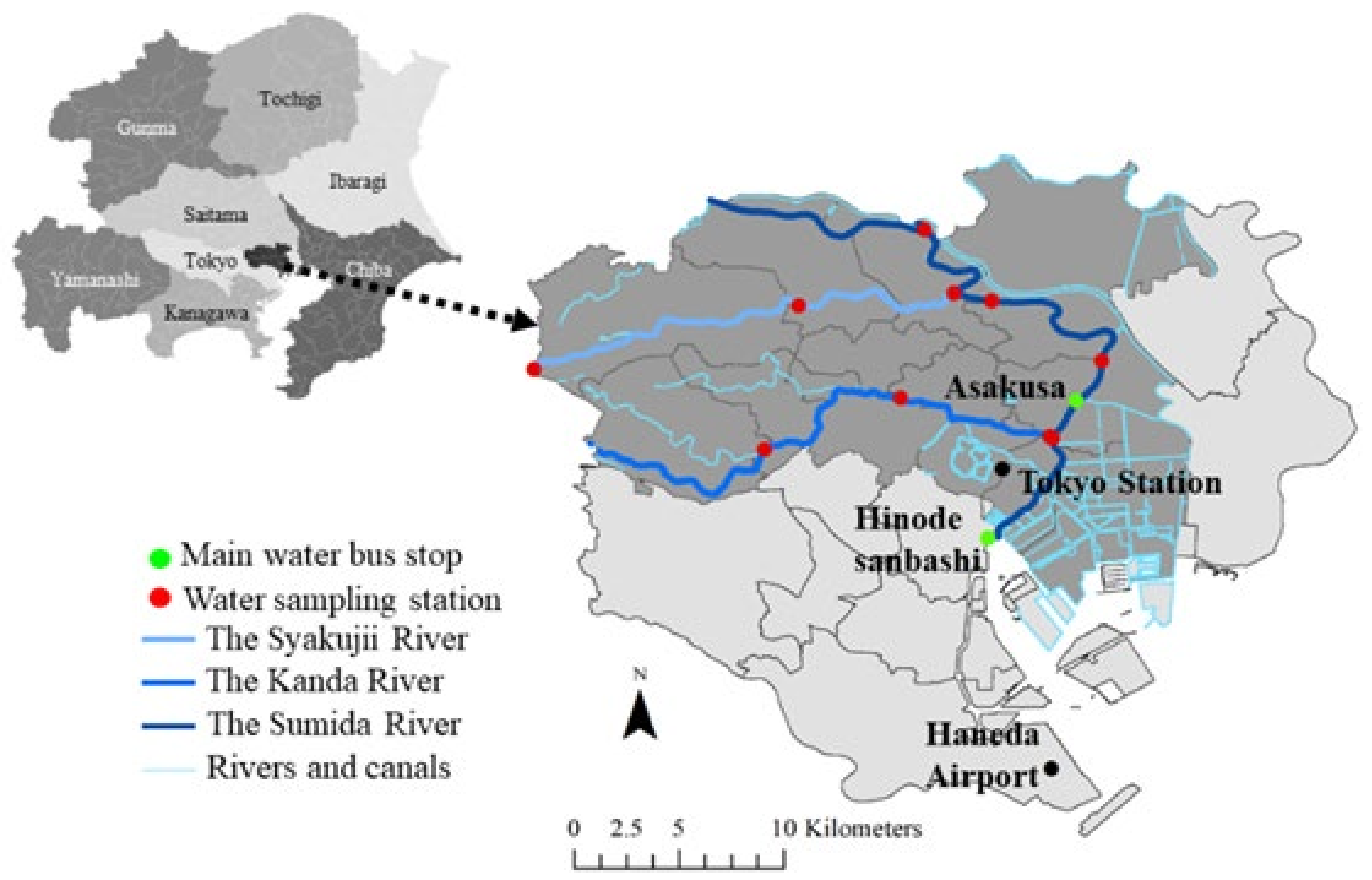
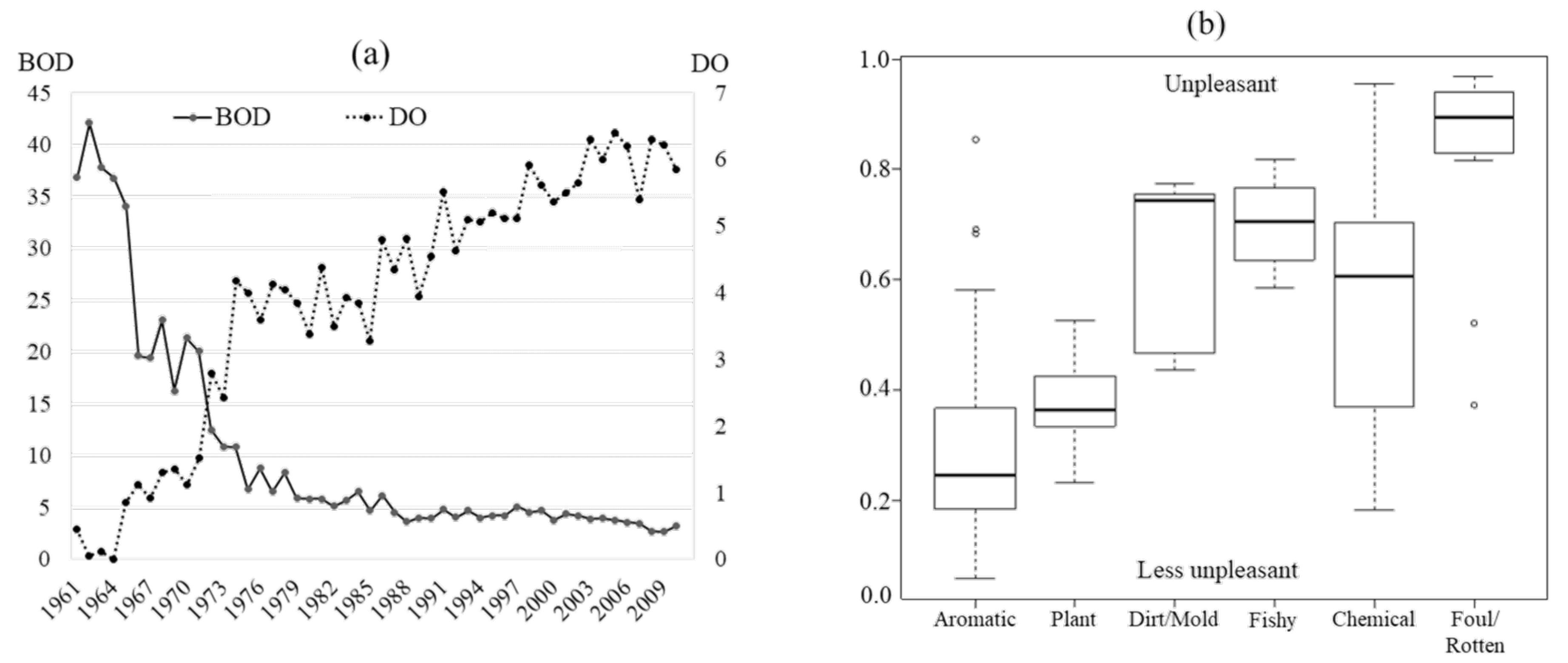
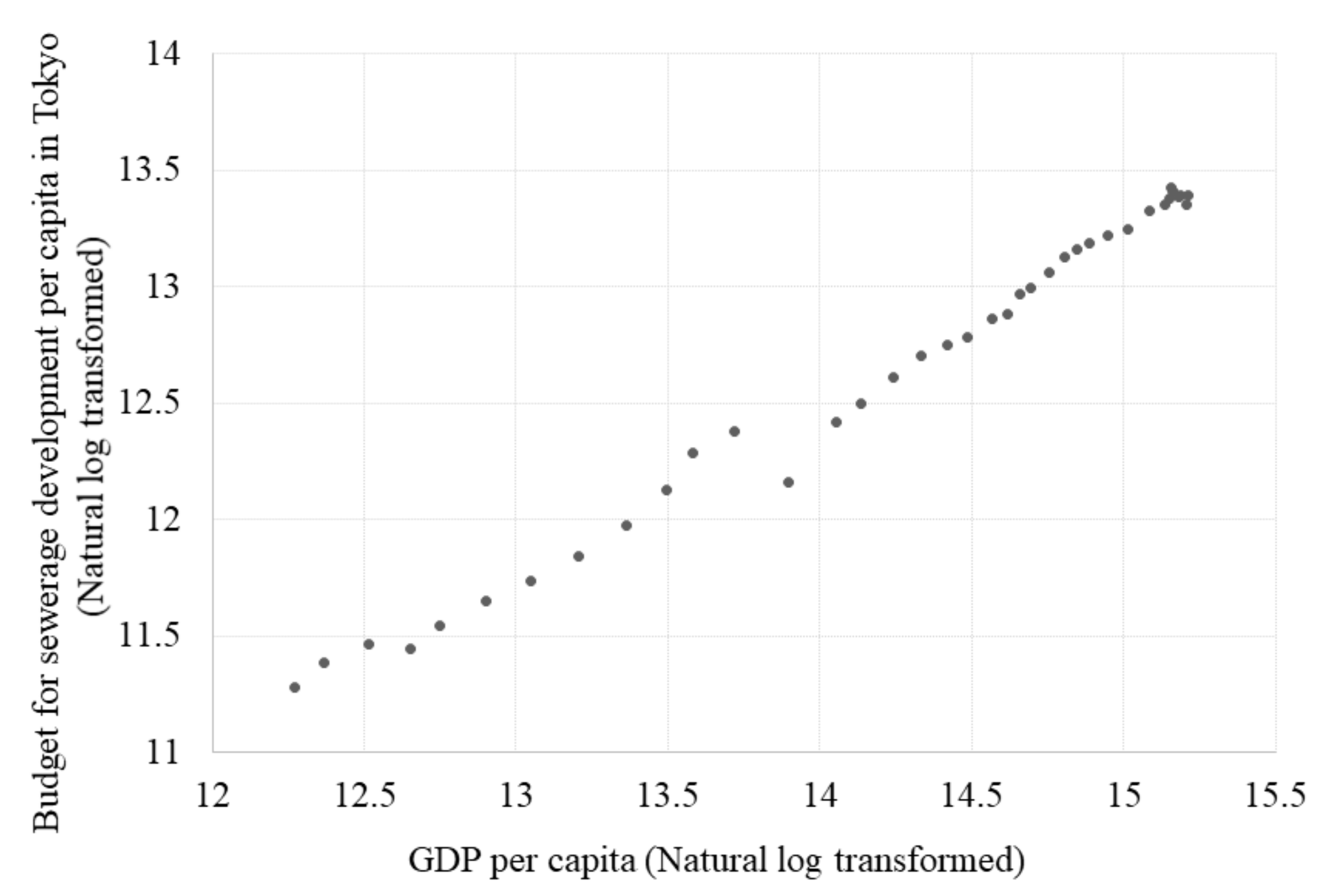
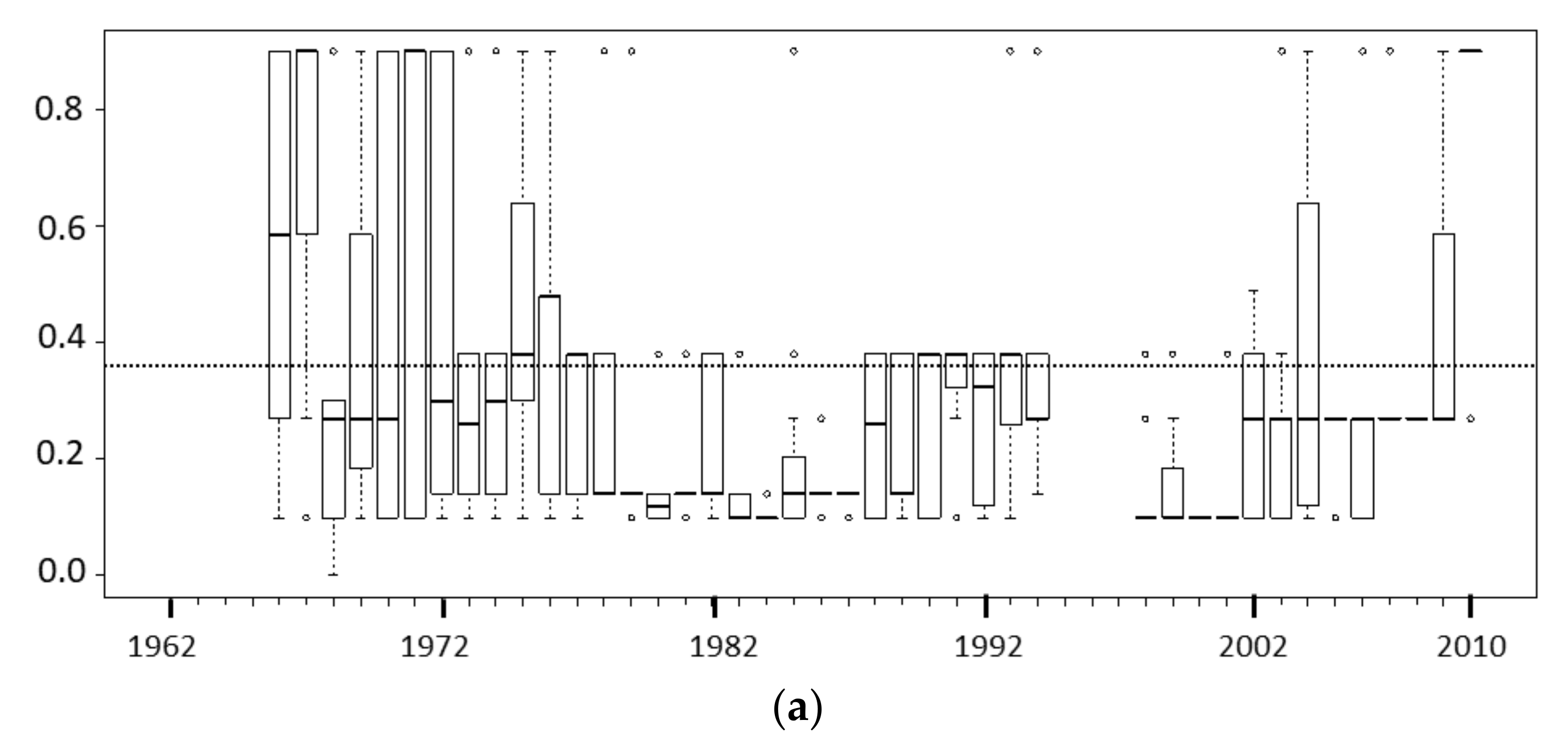
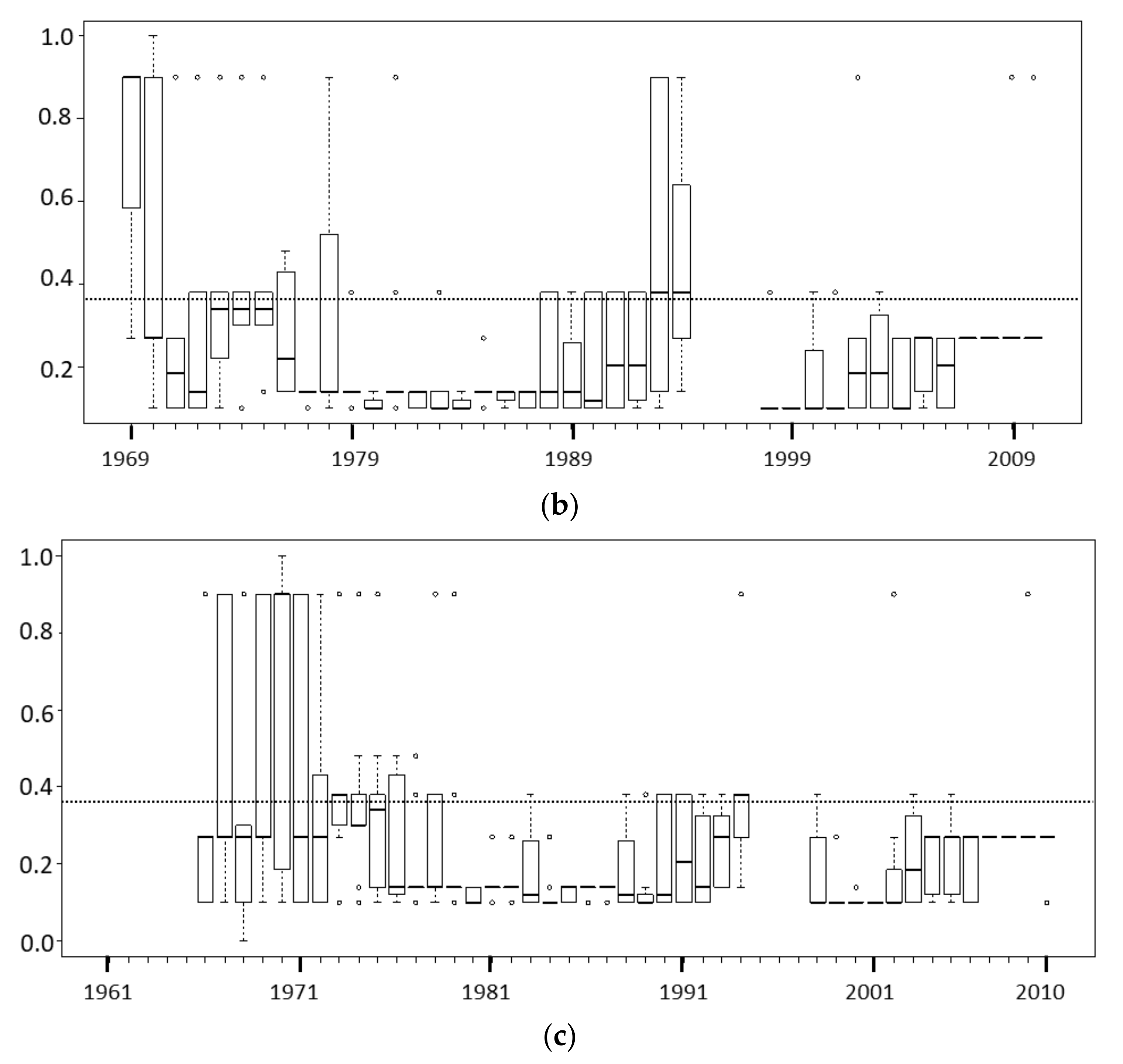
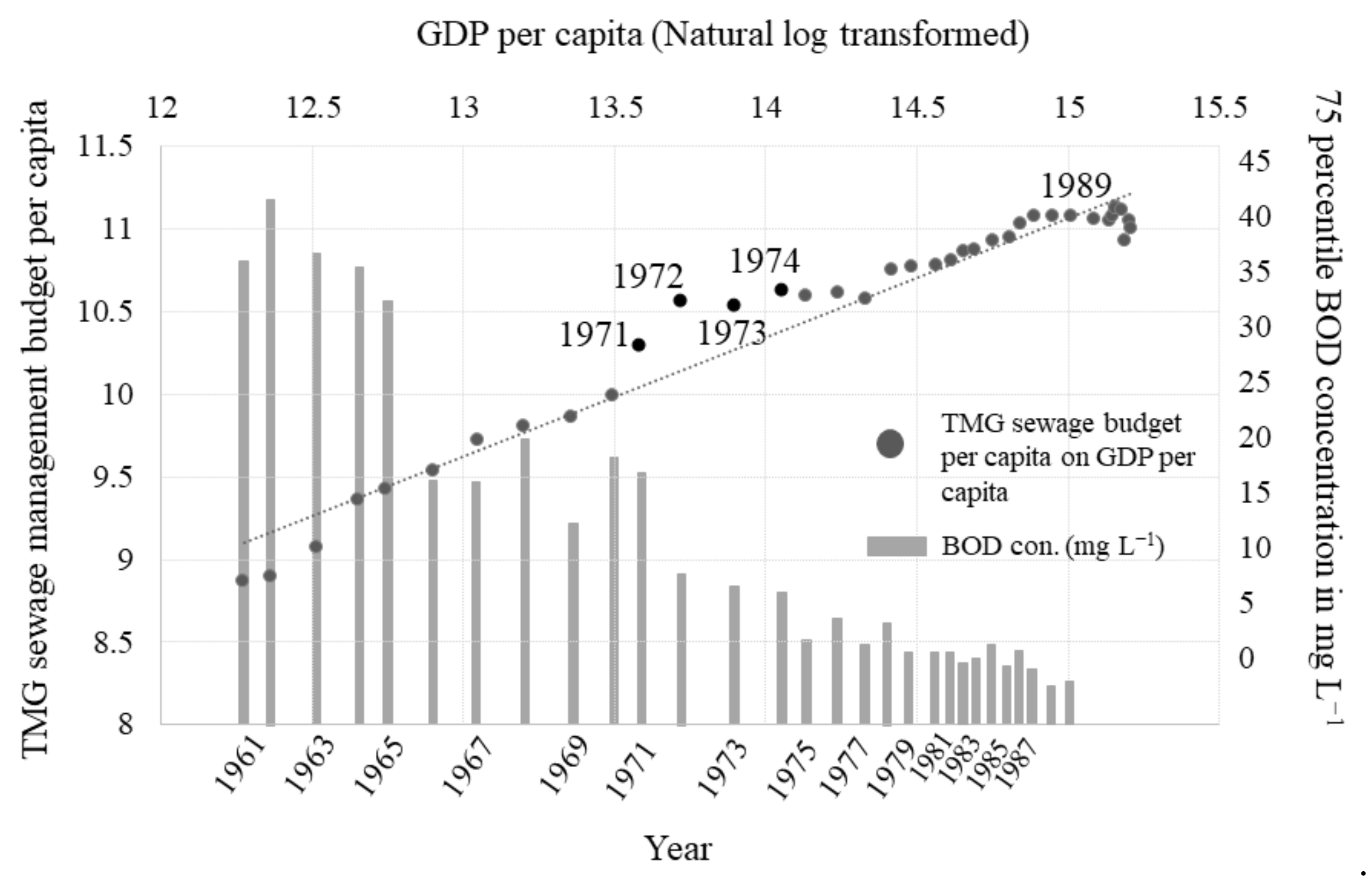
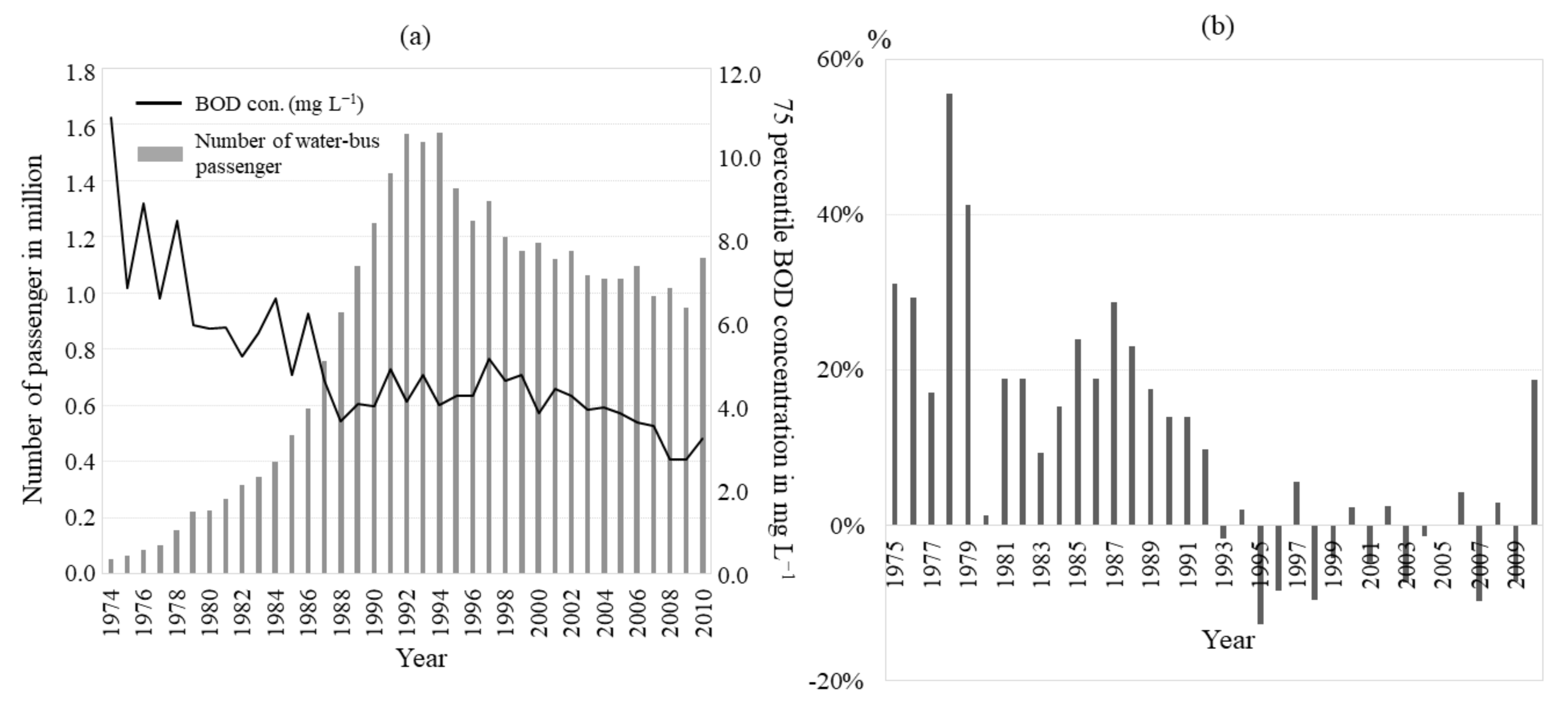
| Impact within Tokyo (JPY) | Impact in All Regions (JPY) | |
|---|---|---|
| 1985 | 15,006,000 | 23,963,000 |
| 1990 | 13,503,500 | 19,591,200 |
| 1995 | 12,608,900 | 17,045,100 |
| 2000 | 13,735,200 | 18,454,400 |
| 2005 | 12,561,900 | 16,422,000 |
| 1985 | 1990 | 1995 | 2000 | 2005 | ||||||
|---|---|---|---|---|---|---|---|---|---|---|
| Sector | JPY | Sector | JPY | Sector | JPY | Sector | JPY | Sector | JPY | |
| 1 | Other transportation-related | 1,575,000 | Finance | 643,600 | Finance | 580,700 | Finance | 969,600 | Finance | 752,000 |
| 2 | Finance | 708,000 | Other transportation-related | 399,100 | Petroleum products | 207,500 | Vessel service | 287,100 | Wholesale | 177,200 |
| 3 | Insurance | 449,000 | Petroleum products | 328,800 | Vessel service | 201,300 | Petroleum products | 246,500 | Advertisement | 151,600 |
| 4 | Petroleum products | 269,000 | Vessel service | 182,200 | Wholesale | 200,600 | Wholesale | 217,900 | Petroleum products | 129,800 |
| 5 | Rent on real estate | 166,000 | Insurance | 173,300 | Insurance | 136,600 | Advertisement | 216,700 | Harbor transportation | 97,400 |
| 6 | Construction/ maintenance | 132,000 | Wholesale | 158,600 | Unidentified | 118,900 | Construction/ maintenance | 112,300 | Construction/ maintenance | 97,200 |
| 7 | Wholesale | 119,000 | Advertisement | 144,800 | Advertisement | 104,200 | Building maintenance | 107,500 | Coal/lignite | 91,700 |
| 8 | Travel agency | 119,000 | Unidentified | 107,900 | Retail | 69,400 | Unidentified | 93,000 | Building maintenance | 83,000 |
| 9 | Telecommunication | 104,000 | Construction/ maintenance | 92,000 | Communication services | 63,600 | Office machine lease | 80,900 | Energy | 70,200 |
| 10 | Advertisement | 91,000 | Travel agency | 89,200 | Telecommunication | 60,400 | Insurance | 75,500 | Communication services | 65,700 |
| 11 and lower | Retail | 58,000 | Retail | 60,000 | Retail | 73,200 | Retail | 34,800 | ||
| Total of the top 10 and retail sectors | 3,790,000 | 2,379,500 | 1,743,200 | 2,480,200 | 1,750,600 | |||||
Publisher’s Note: MDPI stays neutral with regard to jurisdictional claims in published maps and institutional affiliations. |
© 2022 by the authors. Licensee MDPI, Basel, Switzerland. This article is an open access article distributed under the terms and conditions of the Creative Commons Attribution (CC BY) license (https://creativecommons.org/licenses/by/4.0/).
Share and Cite
Inamura, Y.; Kumar, P. Evaluating the Transformation of Urban River Water Quality from Receiving Urban Sewage to a Leisure Venue through an Economic Lens: A Case Study from Tokyo. Earth 2022, 3, 881-894. https://doi.org/10.3390/earth3030051
Inamura Y, Kumar P. Evaluating the Transformation of Urban River Water Quality from Receiving Urban Sewage to a Leisure Venue through an Economic Lens: A Case Study from Tokyo. Earth. 2022; 3(3):881-894. https://doi.org/10.3390/earth3030051
Chicago/Turabian StyleInamura, Yukako, and Pankaj Kumar. 2022. "Evaluating the Transformation of Urban River Water Quality from Receiving Urban Sewage to a Leisure Venue through an Economic Lens: A Case Study from Tokyo" Earth 3, no. 3: 881-894. https://doi.org/10.3390/earth3030051
APA StyleInamura, Y., & Kumar, P. (2022). Evaluating the Transformation of Urban River Water Quality from Receiving Urban Sewage to a Leisure Venue through an Economic Lens: A Case Study from Tokyo. Earth, 3(3), 881-894. https://doi.org/10.3390/earth3030051







